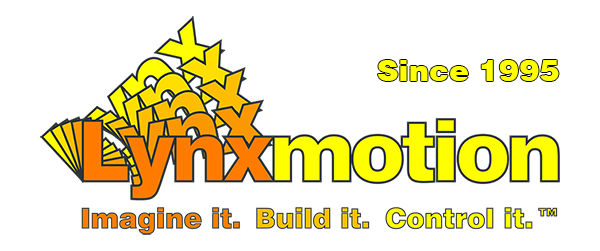Changes for page ses-v2-info (redirect)
Last modified by Eric Nantel on 2024/07/03 10:08
Change comment: There is no comment for this version
Summary
-
Page properties (1 modified, 0 added, 0 removed)
Details
- Page properties
-
- Content
-
... ... @@ -6,14 +6,12 @@ 6 6 * Compatibility with several 3rd party manufacturer products 7 7 * Improved documentation, design and packaging 8 8 9 -** Electronics**:wasbased ontheBotBoarduinoArduino-compatible microcontroller and theSSC-32Uservo controller. Avarietyof servo cable extensions,wiring harnessesandrelatedcabling was used toconnect everything together.The V2 systemfocusesonsmartservocables while stillpermittingRCcontrol.The main electronics for theV2include onlyan adapterandpowerhub.9 +**Actuators & Brackets**: The Lynxmotion SES V1 system uses several models of Hitec RC servo motors, while the Lynxmotion Smart Servo Motors form the basis of the V2 system. Details about the smart servos, their features and more can be found [[here>>doc:Lynxmotion Smart Servo (LSS).WebHome]]. The first SES system used a variety of different Hitec RC servos, and brackets were designed to adapt these servos to to the Erector Set. Although a standard RC servo case size existed for many Hitec servos, several series of brackets had to be created to accommodate different servo sizes (micro, standard and large). Some brackets were designed to have one specific application (for example the body panels for a specific hexapod design) while most were meant to be as modular as possible. In all around 70 brackets were created for the V1 SES system. Disregarding the Hitec RC servo-specific brackets, the remaining brackets from the V1 can mostly be used for the V2 system. The new Lynxmotion Smart Servos were designed to be used with the v1 bracket system in order to create a modular robotic building system called the Lynxmotion Servo Erector Set (S.E.S.) v2. It is therefore entirely possible to create a new robot which uses elements from both the V1 and V2 systems. 10 10 11 -** Hardware**:The LynxmotionServo ErectorSetas always includedboth metricand imperial dimensions,and theV1 systemused almost150 differentscrews,nuts, washers, standoffsand relatedaccessories.The V2 reduces thisdownto lessthan 10, focusing 2-56threadedpanheadscrewsand2-56nutsforbracketconnections,and M3 screws forstandoffs andservohornmounting.11 +**Gearing**: In addition to the various LSS motors, external gears which can be mounted to the servo as well as using a bracket allow additional building options. 12 12 13 -** Main Parts**:LynxmotionSES V1 system uses several models of HitecRCservo motors, whiletheLynxmotionSmart ServoMotorsformthebasis of theV2system.Details about thesmart servos, their features andmore can be found [[here>>doc:Lynxmotion Smart Servo (LSS).WebHome]]. The firstSESsystem useda variety ofdifferentHitec RCservos,and brackets were designed toadapt these servos to to theErector Set. Although astandard RC servo case size existed for many Hitec servos, several series of brackets hadtobe created to accommodate differentservosizes (micro, standardand large). Some brackets were designed to have one specific application (forexample the bodypanels for a specifichexapod design) while most were meant tobe as modularas possible.In all around 70 brackets were created for the V1SES system. Disregarding the HitecRC servo-specificbrackets, the remaining bracketsfrom the V1 can mostly be usedfor the V2 system. The newLynxmotionSmartServoswere designed to be usedwiththe v1 bracket system inordertoreate a modular robotic buildingsystem called the LynxmotionServo Erector Set (S.E.S.) v2.It is therefore entirelypossibletocreate a newrobot which useselementsfrom both the V1andV2systems. The SES V1 providedanoption for 1:1 external gearing, andthe V2 system alsoincludes the optionfor adding external gears(1:1and1:3)which can be mounted to the servo itselfas well as using an external gearbox bracket.Gearsusea standard pitchof16, allowing them tobe compatible with otherspur gears and gear racksof the same pitch.13 +**Hardware**: The bracket system of the V1 system used almost 150 different screws, nuts, washers, standoffs and related accessories. The V2 reduces this down to less than 10, focusing on 2-56 and 4-40 screws, nuts and standoffs, and M3 for servo horns. 14 14 15 -**Power**: T.B.D 16 - 17 17 **Software**: Software includes a new version of FlowArm designed for using the smart servos, as well as libraries in Arduino, Python and ROS. Additional software to come. 18 18 19 - 17 +**Electronics**: The V1 system was based on the BotBoarduino Arduino-compatible microcontroller and the SSC-32U servo controller. A variety of servo cable extensions, wiring harnesses and related cabling was used to connect everything together. The V2 system focuses on smart servo cables while still permitting RC control. The main electronics for the V2 include only an adapter and power hub.

